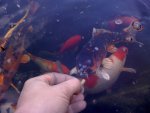If it's koi pox, isolating a fish pretty much does no good because it you've seen the warts, the water and others are already "infected." However, it does not mean that any of the others will show any of the symptoms or maybe only a few will. I mean, you'd basically have to isolate the fish permanently. It will always carry the virus for the rest of its life.
If it is koi pox, you either just live with it knowing that it will likely just come and go as the weather temps change; or you destroy the fish who has it. The virus is already in the environment and can't be removed (you can't, for example, drain the water and scrub the pond to get rid of it). Any new fish you introduce to the pond or any of that herd of fish, will become exposed to the virus as well. Again, it doesn't mean the the other fish will ever show symptoms. Some might, some may not. Short of eliminating that entire herd of fish you own, there is no way of eradicating the virus since they have all been exposed to it.
Also, you must never give away any of the fish in your pond to anyone else EVER. You either have to let them live out their natural lifespan in your pond or destroy them. If any of those fish are introduced into someone else's pond, their fish will be exposed to the virus as well. And, well, that's how virus spread...ongoing exposure.
I have a similar situation in my pond, actually. It's not with koi pox, but with lympocystitis. It's similar in that a fish or two may develop white pimples. Of my entire herd, 3 get affected. It lasts 1-3 months on the fish, and then goes away. They sort of look like pimply teenage boys. It has a slightly different appearance than koi pox, but is a virus nonetheless and has no cure, too. It starts out where you think you have something like ich or maybe a case of impending anchor worm, but then the pimples get slightly larger and mass together kinda like cauliflower (which is why it's also called cauliflower disease).
Lymphocystis doesn't harm the fish at all. They go about their business as if normal. They eat well, swim about like usual, etc. It does not kill the fish that it affects. It looks darned ugly on the fish, however. Once the fish gets the pimples, it does not seem to get them again. It's sort of like the chicken pox, you get it once and that's it. You develop a resistance to it and don't get it again.
I'll apologize for the pic quality as it's hard to chase around a quick moving fish with a 200mm lens that is heavy. Here's a pic of my mutt kohaku with lymphocystitis at its absolute worst stage:
and here is a photo with one of my common goldies with it:
How did my fish get lymphocystitis? And how did your fish get koi pox (if that's what it is)? Being a virus it gets introduced when you add a fish that has been exposed to it. In my case, I purchased some goldfish from a very well known and respected breeder. Within 1 month of putting them in my pond, I began seeing the symptoms in the common goldie and a month later that kohaku koi. I had NEVER had any virus or disease in my pond before the introduction of these fish in all the years I've had the pond, so therefore, I can isolate the problem directly to the introduction of these fish into my pond. My water quality is perfect and my water parameters are ideal, so I knew it wasn't the water. And I hadn't added any new fish to the pond in the year before I got those goldies.
It's just kinda like the lottery, and luck of the draw. You either live with it in your pond and keep good water quality so those fish don't get hit with a secondary infection of some kind or you kill all the fish, get rid of all your filter media, and scrub everything else with bleach. Personally, I just accept what I have and recognize that when I introduce a new fish, it will be exposed. It doesn't stop me from acquiring new fish. I just added two new koi to my pond--a butterfly and a gin rin ogon. Both have not gotten any of the symptoms, but they've been exposed nonetheless.




